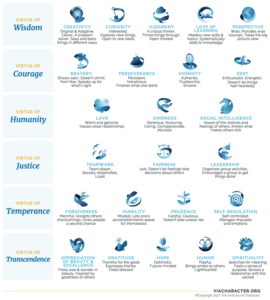This reflection stems from the need to recognize the invaluable resources each person can bring to the organization when more emphasis is placed on their character strengths. Each person possesses a series of unique positive dispositions that can be defined as character strengths expressed in thoughts, feelings, and behaviors (Park et al., 2004). Character strengths are unique personal traits that define oneself and leveraging them is helpful to thrive in personal and professional contexts. Character strengths are a resource largely untapped by organizations. Peterson and Park (2006) underlined how people aware of their character strengths are more engaged in what they do and find significance beyond their activities. They tend to experience more satisfaction with their lives and, consequently, are happier, healthier, more resilient, and more productive.
This reflection highlights how strength interventions aimed at uncovering employees’ character strengths can positively impact organizational dynamics. Research has demonstrated that strength interventions enhance people’s ability to plan or envision using their strengths in the future: either by using them in new ways, identifying how strengths will feature in future successes, or planning to develop a particular strength or weakness. People are empowered to plan, visualize a different future, and set goals. The focus of strengths intervention research thus far has been to demonstrate that strengths interventions can have a reliable, positive effect on participant well-being, academic self-efficacy, or achievement (Quinlan et al., 2012).
People’s strengths
Peterson and Seligman (2004) have developed a classification of 24-character strengths classified under six main virtues:
- Wisdom and knowledge—Cognitive strengths linked to gaining and applying knowledge.

- Courage—Emotional strengths refer to the ability to use willpower to achieve goals despite facing opposition from external sources or within oneself.
- Humanity— Interpersonal strengths can be reflected in their ability to nurture and create friendships.
- Justice—Civic strengths linked to supporting healthy community life.
- Temperance—Strengths protecting against excess
- Transcendence—Strengths that enhance relationships with the larger context and provide meaning (Peterson & Park, 2009).
It is vital to balance three essential components to promote a strengths intervention: strength identification, development, and use through various techniques and strategies. The Values in Action (VIA) survey (Peterson & Seligman, 2004) is a validated tool helpful in identifying employees’ most dominant strengths. A fruitful use of this instrument is identifying one’s three to seven top strengths and inviting people to use these strengths in new ways. The development and use of strengths entail motivating employees to cultivate and refine their strengths, and coaching can be a robust methodology to support this process.
Organization’s strengths
Peterson and Park (2006) have identified organizational-level virtues as an enduring part of organizational culture. These are moral characteristics of the organization that goes beyond simple summaries or composites of characteristics of the organization’s members.
- Purpose: A shared vision of the moral goals of the organization.
- Safety: Protection against threat, danger, and exploitation that can undermine physical and psychological well-being.
- Fairness: Fair regulations are in place to govern both rewards and misconduct, promoting a healthy balance of competition and cooperation.
- Humanity: Mutual care, concern, and collective compassion.
- Dignity: The treatment of all people in the organization as individuals regardless of their position.
Adopting the language of character strengths helps articulate the moral aspects of corporate identity. These organizational-level virtues are associated with increased employee autonomy and involvement and decreased mismanagement, abuse, and overwork. A good organization can inspire its members to be more than employees who respond to orders and fulfill given tasks; they can contribute to the organization’s development using their unique talents. Organizations that promote these strengths are more likely to enhance employees’ relationships and a wider positive group environment.
Organizations should implement practices and norms that recognize, celebrate, and encourage identifying employees’ unique character strengths. Strength interventions are necessary to enhance employees’ ability to recognize and leverage their character strengths in their professional contexts, engage them in establishing relevant and meaningful goals, and support and encourage ongoing strengths use. Implementing character strengths within organizations can predict humanizing organizations, increasing employees’ level of engagement, mitigating the dramatic challenges posed by the new hybrid work normality, and reducing the increase in stress, social distancing, and virtual working (Bhatnagar et al., 2020). The increased positive feelings of vitality, competence, and authenticity elicited through focusing on strengths (Peterson & Seligman, 2004) become active ingredients in increasing engagement, performance, and well-being at work (Miglianico et al., 2020). Strength interventions effectively enhance individual strategies, well-being, personal resources, and performance.
References
Bhatnagar, V. R., Jain, A. K., Tripathi, S. S., & Giga, S. (2020). Human strengths: a systematic conceptual review, conceptualizing employee strengths at work and a framework for management development. Journal of Management Development, 40(1), 1–22. https://doi.org/10.1108/JMD-03-2020-0080
Miglianico, M., Dubreuil, P., Miquelon, P., Bakker, A. B., & Martin-Krumm, C. (2020). Strength use in the workplace: A literature review. Journal of Happiness Studies, 21(2), 737–764. https://doi.org/10.1007/s10902-019-00095-w
Park, N., Peterson, C., & Seligman, M. E. P. (2004). Strengths of character and well-being. Journal of Social and Clinical Psychology, 23(5), 603–619. https://doi.org/10.1521/jscp.23.5.603.50748
Peterson, C., & Park, N. (2006). Character Strengths in Organizations. Journal of Organizational Behavior, 27(8), 1149–1154. http://www.jstor.org/stable/4093906
Peterson, C., & Park, N. (2009). Classifying and measuring strengths of character. In S. J. Lopez & C. R. Snyder (Eds.), Oxford handbook of positive psychology (pp. 25–33). Oxford University Press.
Peterson, C., & Seligman, M. E. P. (2004). Character strengths and virtues: A handbook and classification. Oxford University Press.
Quinlan, D., Swain, N., & Vella-Brodrick, D. A. (2012). Character strengths interventions: Building on what we know for improved outcomes. Journal of Happiness Studies: An Interdisciplinary Forum on Subjective Well-Being, 13(6), 1145–1163. https://doi.org/10.1007/s10902-011-9311-5








